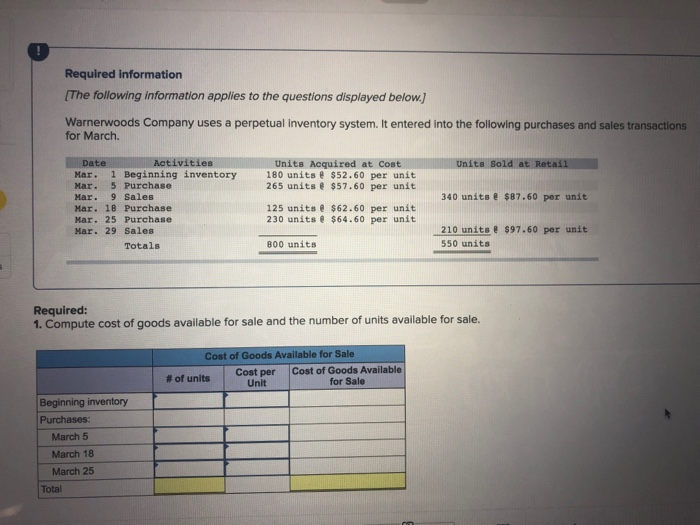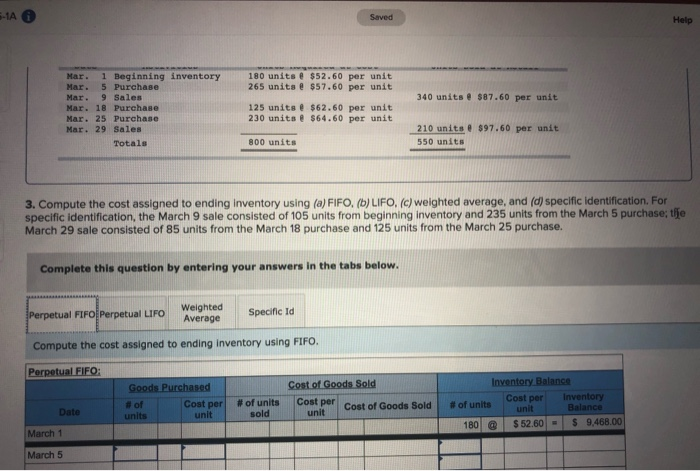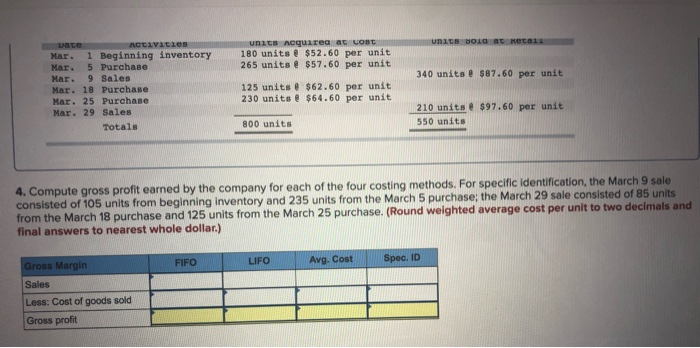Required information (The following information applies to the questions displayed below.) Warnerwoods Company uses a perpetual inventory system. It entered into the following purchases and sales transactions for March. Units Sold at Retail Date Activities Mar. 1 Beginning inventory Mar. 5 Purchase Mar. 9 Sales Mar. 18 Purchase Mar. 25 Purchase Mar. 29 Sales Totals Units Acquired at Cost 180 units @ $52.60 per unit 265 units $57.60 per unit 125 units @ $62.60 per unit 230 units @ $64.60 per unit 340 units @ $87.60 per unit 210 units e $97.60 per unit 550 units 800 units Required: 1. Compute cost of goods available for sale and the number of units available for sale. Cost of Goods Available for Sale Cost per Cost of Goods Available # of units Unit for Sale Beginning inventory Purchases: March 5 March 18 March 25 Total 2. Compute the number of units in ending inventory. Ending inventory units S-1A Saved Help 180 units @ $52.60 per unit 265 units @ $57.60 per unit 340 units $87.60 per unit Mar. 1 Beginning inventory Mar. 5 Purchase Mar. 9 Sales Mar. 18 Purchase Mar. 25 Purchase Mar. 29 Sales Total 125 units $62.60 per unit 230 units @ $64.60 per unit 210 units $97.60 per unit 550 units 800 units 3. Compute the cost assigned to ending Inventory using (a) FIFO, (b) LIFO, (c) weighted average, and (d) specific identification. For specific identification, the March 9 sale consisted of 105 units from beginning inventory and 235 units from the March 5 purchase; the March 29 sale consisted of 85 units from the March 18 purchase and 125 units from the March 25 purchase. Complete this question by entering your answers in the tabs below. Perpetual FIFO Perpetual LIFO Weighted Average Specific Id Compute the cost assigned to ending inventory using FIFO. Perpetual FIFO Goods Purchased Cost of Goods Sold Cost per Cost of Goods Sold unit Cost per Cost per #o units Date Inventory Balance Inventory # of units unit Balance 180 @ $ 52.60 - $ 9,468.00 # of units sold unit March 1 March 5 units bona at Retai units nequareg at LOBE 180 units $52.60 per unit 265 units e $57.60 per unit 340 unitse $87.60 per unit Date ACTIVaties Mar. 1 Beginning inventory Mar. 5 Purchase Mar. 9 Sales Mar. 18 Purchase Mar. 25 Purchase Mar. 29 Sales Totals 125 units @ $62.60 per unit 230 units @ $64.60 per unit 210 units $97.60 per unit 550 units 800 units 4. Compute gross profit earned by the company for each of the four costing methods. For specific identification, the March 9 sale consisted of 105 units from beginning inventory and 235 units from the March 5 purchase; the March 29 sale consisted of 85 units from the March 18 purchase and 125 units from the March 25 purchase. (Round weighted average cost per unit to two decimals and final answers to nearest whole dollar.) FIFO LIFO Avg. Cost Spec. ID Gross Margin Sales Less: Cost of goods sold Gross profit










